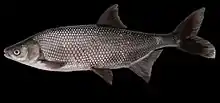Lavinia exilicauda
The hitch (Lavinia exilicauda) is a cyprinid fish endemic to central California, and was once very common. The name is derived from the Pomoan word for this species.
| Hitch | |
|---|---|
 | |
| Scientific classification | |
| Kingdom: | Animalia |
| Phylum: | Chordata |
| Class: | Actinopterygii |
| Order: | Cypriniformes |
| Family: | Cyprinidae |
| Subfamily: | Leuciscinae |
| Genus: | Lavinia |
| Species: | L. exilicauda |
| Binomial name | |
| Lavinia exilicauda | |
| Synonyms | |
Description
The hitch shape is deep and laterally compressed, with a small head, and a terminal mouth pointing upwards. They are generally silver all over; younger fish have a black spot at the base of the tail, losing it as they age, and becoming generally darker as well. The anal fin is noticeably longer than for other California minnows, with 11-14 rays, while the dorsal fin has 10-13 rays, and is placed further back, the base being positioned between pelvic and anal fins. The tail fin is large and deeply forked. They can get large for minnows, with lengths of up to 36 cm. All of these features make them look much like the golden shiner. The hitch is closely related to the California roach (Hesperoleucus symmetricus complex), and these taxa can hybridize with each other.[2]
Hitch are omnivores of the open water, eating a combination of filamentous algae, insects, and zooplankton. They can be found in lakes, sloughs, and slow-moving sections of rivers and streams. With the highest temperature tolerance among the native fish of the Central Valley, they can be found in both warm and cool water; they also have considerable salt tolerance, for instance occurring in Suisun Marsh (7-8 ppt salinity), and Salinas River lagoon (9 ppt).
Distribution
Their range includes the Sacramento River-San Joaquin River System of the Central Valley, the Russian River, Clear Lake, Pajaro River, and Salinas River. Although once abundant, but no longer commercially fished in Clear Lake, populations have been declining. The most likely cause appears to be loss of springtime spawning water flows due to water diversion and damming.
References
- NatureServe (2013). "Lavinia exilicauda". The IUCN Red List of Threatened Species. 2013: e.T202129A18230971. doi:10.2305/IUCN.UK.2013-1.RLTS.T202129A18230971.en.
- Baumsteiger J, Moyle PB 2019. A reappraisal of the California Roach/Hitch (Cypriniformes, Cyprinidae, Hesperoleucus/Lavinia) species complex Zootaxa 4543 (2): 221–240
- "Lavinia exilicauda". Integrated Taxonomic Information System. Retrieved 18 April 2006.
- Peter B. Moyle, Inland Fishes of California (University of California Press, 2002), pp. 136–139
- Froese, Rainer and Pauly, Daniel, eds. (2006). "Lavinia exilicauda" in FishBase. April 2006 version.
